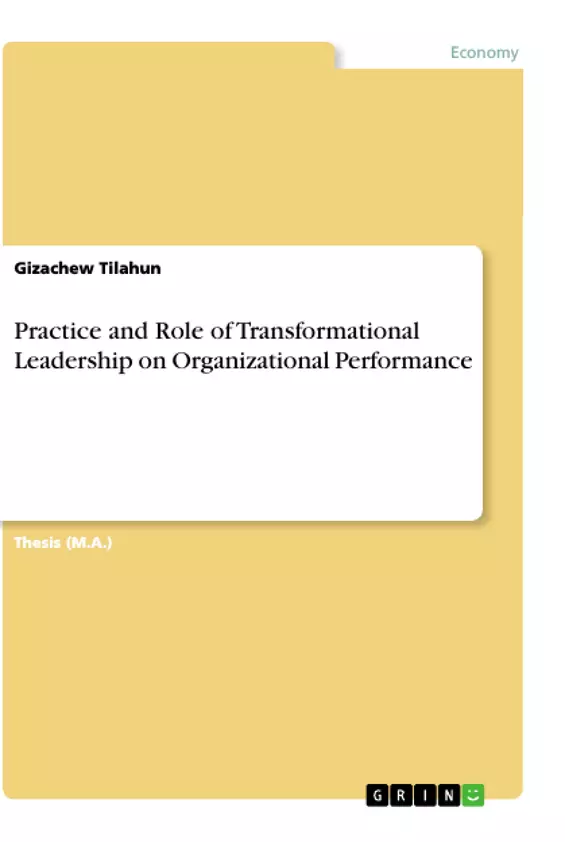The general objective of the study is to investigate the practice and role of transformational leadership on organizational performance in City government of Addis Ababa. Leaders have a vital role in motivating and inspiring employees to perform their job more than they originally expected from them. In this regard, transformational leadership gives emphasis on inherent motivation and followers’ development, which fits the needs of today’s complex work groups, who want to be inspired and empowered in order to achieve the predetermined goal of their organization. Thus, this study was conducted to assess the practice and role of transformational leadership on organizational performance in public organizations of AACA.
To this end, concurrent research design was adopted. The study was conducted in fifty public organizations of two sub cities selected through stratified simple random sampling techniques. From these organizations, 431 participants were selected through proportionate, simple random and purposive sampling techniques. Questionnaires containing open and close-ended items and semi-structured interview were employed in the process of data gathering. The quantitative data were analyzed by utilizing frequency, percentages, mean, standard deviations, correlation, and regression. The data gathered through interviews and open-ended questions were categorized to groups to supplement the quantitative data.
Inhaltsverzeichnis (Table of Contents)
- ACKNOWLEDGEMENT
- BIOGRAPHY
- LIST OF TABLE
- LIST OF FIGURES
- LIST OF ACRONYMS
- ABSTRACT
- CHAPTER ONE
- INTRODUCTION
- 1.1. BACKGROUND OF THE STUDY
- 1.2. STATEMENTS OF THE PROBLEMS
- 1.3. OBJECTIVES OF THE STUDY
- 1.4. RESEARCH QUESTIONS
- 1.5. SCOPE OF THE STUDY
- 1.6. LIMITATIONS OF THE STUDY
- 1.7. SIGNIFICANCE OF THE STUDY
- 1.8. OPERATIONAL DEFINITIONS OF SOME KEY TERMS
- 1.9. ORGANIZATION OF THE STUDY
- CHAPTER TWO
- LITERATURE REVIEW
- 2.1. INTRODUCTION
- 2.2. THEORIES AND CONCEPTS OF TERMS
- 2.3. EMPIRICAL LITERATURE
- 2.4. RESEARCH GAP
- CHAPTER THREE
- RESEARCH METHODOLOGY
- 3.1. INTRODUCTION
- 3.2. DESCRIPTION OF THE STUDY AREA
- 3.3. RESEARCH APPROACH
- 3.4. RESEARCH DESIGN
- 3.5. VARIABLES OF THE STUDY
- 3.6. POPULATION AND SAMPLING PROCEDURE
- 3.7. SAMPLE FRAME
- 3.8. SAMPLING TECHNIQUES AND SAMPLE SIZE DETERMINATION
- 3.9. DATA SOURCES AND DATA GATHERING INSTRUMENTS
- 3.10. DATA QUALITY CONTROL MECHANISMS
- 3.11. DATA ANALYSIS
- 3.12. ETHICAL CONSIDERATION
- CHAPTER FOUR
- DATA PRESENTATION, ANALYSIS AND DISCUSSION
- 4.1. INTRODUCTION
- 4.2. RESPONSE RATE OF RESPONDENTS
- 4.3. DEMOGRAPHIC CHARACTERISTICS OF RESPONDENTS
- 4.4. PRESENTATION AND DISCUSSION OF SURVEY AND INTERVIEW RESULT
Zielsetzung und Themenschwerpunkte (Objectives and Key Themes)
This thesis aims to examine the impact of transformational leadership on organizational performance in the Addis Ababa City Administration. The research focuses on understanding how transformational leadership practices influence the effectiveness and success of organizations within this specific context. The thesis explores the relationship between transformational leadership and key organizational performance indicators.
- Transformational Leadership Styles and Practices
- Organizational Performance Metrics and Indicators
- Impact of Transformational Leadership on Organizational Performance
- Factors Influencing the Effectiveness of Transformational Leadership
- Recommendations for Enhancing Transformational Leadership in Organizations
Zusammenfassung der Kapitel (Chapter Summaries)
- Chapter One provides a comprehensive introduction to the research, outlining the background, problem statement, objectives, research questions, scope, limitations, significance, and operational definitions of key terms. It also details the organization of the study.
- Chapter Two delves into a thorough review of existing literature on transformational leadership and organizational performance. This chapter examines various theories and concepts related to the topic, explores relevant empirical studies, and identifies research gaps that the current thesis aims to address.
- Chapter Three focuses on the research methodology employed in the study. It describes the study area, research approach, design, variables, population and sampling procedures, data sources, data collection instruments, data quality control mechanisms, data analysis methods, and ethical considerations.
- Chapter Four presents the collected data, analyzes the findings, and discusses the results. It examines the response rate of respondents, analyzes demographic characteristics, and provides an in-depth discussion of the survey and interview results.
Schlüsselwörter (Keywords)
The main keywords and focus topics of this thesis are: transformational leadership, organizational performance, Addis Ababa City Administration, Ethiopia, leadership styles, organizational effectiveness, empirical research, case study, quantitative and qualitative data analysis.
- Quote paper
- Gizachew Tilahun (Author), 2020, Practice and Role of Transformational Leadership on Organizational Performance, Munich, GRIN Verlag, https://www.grin.com/document/1006981



